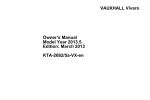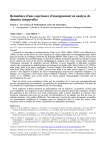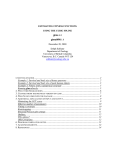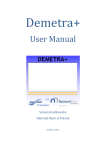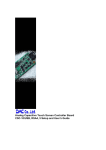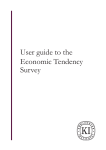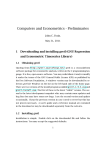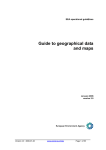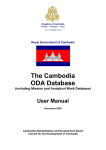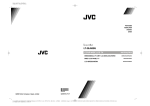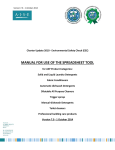Download Working Instructions for Beginning Seasonal Adjustment
Transcript
STATISTICAL COMMISSION ECONOMIC COMMISSION FOR EUROPE Working Instructions for Beginning Seasonal Adjustment with Demetra+1 UNITED NATIONS Economic Commission for Europe Economic Statistics Section February 2011 1 Paper prepared by Anu Peltola, UNECE Statistical Division. Contents Introduction ......................................................................................................... 3 1. Prepare and check............................................................................................ 4 1.1 Open Demetra+............................................................................................................... 4 1.2 Prepare a source file........................................................................................................ 5 1.3 Import data...................................................................................................................... 6 1.4 Check the original series................................................................................................. 8 2. Define and adjust........................................................................................... 10 2.1 Select an approach ........................................................................................................ 10 2.2 Prepare calendars .......................................................................................................... 11 2.3 Select regressors ........................................................................................................... 11 2.4 Seasonally adjust .......................................................................................................... 12 3. Analyse and refine......................................................................................... 16 3.1 Visual checks ................................................................................................................ 16 3.2 Models applied ............................................................................................................. 17 3.3 Quality diagnostics ....................................................................................................... 21 3.4 Refine and readjust ....................................................................................................... 25 4. Document and publish................................................................................... 27 4.1 Document choices......................................................................................................... 27 4.2 Export data.................................................................................................................... 27 4.3 Prepare publication ....................................................................................................... 28 4.4 Support users ................................................................................................................ 29 References ......................................................................................................... 29 Introduction These working instructions for using Demetra+ software aim to support the introduction of seasonal adjustment procedures. Many international handbooks and recommendations give more details about the theoretical background of seasonal adjustment, whereas these instructions offer practical guidance. The main references used in this paper are the European Statistical System (ESS) Guidelines on Seasonal Adjustment and the Demetra+ User Manual. Demetra+ is seasonal adjustment software provided by Eurostat, free of charge, on the Internet. It includes a choice of the two seasonal adjustment methods, X-12-ARIMA2 and TRAMO/SEATS3. The aim of creating the new seasonal adjustment software, Demetra+ was to supply a more flexible tool that reflects the ESS guidelines. Demetra+ comprises many panel windows for different functionalities. It interacts well with other software, and efficiently adjusts a large number of time series. As Demetra+ does not guide the user through the seasonal adjustment process, these instructions suggest a process to follow. Seasonal adjustment is important, because it makes data easier to interpret and allows international comparison. The purpose is to simplify the data so that the direction of development becomes more visible without a significant loss of information. Seasonal adjustment tries to identify and remove seasonality, i.e. repeating patterns in the data. When seasonality influences the raw data, it conceals the true underlying economic development. By eliminating the seasonal movements, comparison of data between two different months or quarters becomes possible. The seasonally adjusted data also allow comparison of different series with different seasonal patterns, i.e. international comparison of economic development. Sometimes we compare the same month of consecutive years as a substitute for seasonal adjustment. However, these year-on-year changes do not remove all seasonal effects. Moving holidays may interfere with the year-on-year changes: if Easter falls in March instead of April the level of activity can change greatly. In addition, the year-on-year changes ignore trading day effects and contain the irregular movements that do not reflect general economic activity. Furthermore, there are time delays when identifying turning points from the raw data. For example, if November 2010 is lower than November 2009, we do not know when the decrease has really started. The seasonally adjusted data offer a possibility to calculate change from the previous month, as a result providing a faster and easier detection of the economic cycle. This paper identifies four phases in seasonal adjustment with Demetra+: 1. Prepare and check; 2. Define and adjust; 3. Analyse and refine; and 4. Document and publish. These working instructions follow the process for seasonal adjustment as outlined in the next chart (see table 1). 2 3 ARIMA = Auto-Regressive Integrated Moving Average TRAMO = Time series Regression with ARIMA noise, Missing observations and Outliers SEATS = Signal Extraction in ARIMA Time Series 3 Table 1: Seasonal adjustment with Demetra+ step-by-step Open Demetra+ Prepare & Check Prepare a source file Import data Check the original series Select an approach Define & Adjust Prepare calendars Select regressors Seasonally adjust Visual check Analyse & Refine Models applied Quality diagnostics Refine and readjust Document choices Document & Publish Export data Prepare publication Support users 1. Prepare and check 1.1 Open Demetra+ The User Manual and other user documentation contain essential instructions for the use of the software. For installation of Demetra+ software go to: http://circa.europa.eu/irc/dsis/eurosam/info/data/demetra.htm The National Bank of Belgium developed Demetra+ for Eurostat. The software includes: • TRAMO/SEATS supported by Bank of Spain, by V. Gómez and A. Maravall, • X-12-ARIMA of the US Census Bureau. To start, open Demetra+ software. It consists of different panels (see image 1): • Browsers panel (left) presents the time series; • Workspace panel (right) shows information used or generated by the software; • Results panel (central) contains the analyses; • TS Properties panel (at the bottom) contains the current time series from the browser, and • Logs panel (bottom, left) contains log information. 4 Image 1: Panels of Demetra+ The user can move, resize and close panels as needed. Time series are easy to drag and drop between panels. You can re-open closed panels through the main menu commands: Workspace->View. Demetra+ saves the chosen presentation mode. 1.2 Prepare a source file Demetra+ provides an easy process for importing data from several types of files. These instructions provide guidance for importing data from an Excel file. The Demetra+ User Manual contains further instructions about using other types of source files. Select the data that you wish to seasonally adjust and prepare an Excel file. The Excel file has to meet certain criteria to be a suitable input for Demetra+. You can arrange the set of time series vertically or horizontally. The user can create and import data sets from Excel. The format of the series in Excel should be as follows: • True dates in the first copied column; • Titles of the series in the corresponding cell of the first row; • Time series area formatted as numbers; • Empty top-left cell [A1]; • Empty cells in the data zone correspond to missing values (except at the beginning and at the end of the series). 5 Image 2: A vertical data file In the vertical file, give the names of the time series on the first row. The first column contains information on data periodicity, as well as the starting and ending dates of the series. A horizontal presentation is also possible and it follows the same lay out with the series names on the first column, and periodicity on the first row. 1.3 Import data Once your data in an Excel file applies to the previous instructions, you can start importing them. There are several alternative ways to import data. The first option for importing data enables dynamic updates of the time series from the source file. This means that next time you do not have to import the data again. Demetra+ will read the updated data from the original file as long as it remains in the same location with the same name. Option 1 Open an Excel file • Click on the Excel tab of the Browsers panel; • Click on the • Choose an Excel workbook from your folders button on the left to Add a workbook; 6 Image 3: Importing data to Demetra+ Number of series in the file 1 2 Name and number of series in the spreadsheet Option 2 Copy and paste: • • • • • Image 4: Option 2 for importing Select the entire data including the dates and titles in the Excel file. Copy; Click on the Xml tab in the Browsers panel; Select Paste and the data will appear in the tree. If you have other files opened this way, the Browsers panel needs to be cleared by selecting New; You may change the name of the series in the tree if necessary by clicking twice on the item you would like to modify; Save the file if need be. If you copy and paste the data by dragging and dropping the automatic update of data is not available. You can Add, Remove or Clear the contents of the Browsers panel by right clicking on any . This will remove all the contents. name of time series, and selecting 7 1.4 Check the original series The quality of seasonal adjustment depends on the quality of the raw data. It is, therefore, necessary to first check the original data: to consider the accuracy, length of time series, quality of production methods and consistency of time series. Visual analysis of time series is often helpful. It can help to identify the possible outliers, missing values, volatility, presence of seasonality and breaks in the seasonality or trend of the time series. At this stage, you can document any weaknesses for other colleagues and for informing the users of statistics. For seasonal adjustment, the time series has to be at least 3 years long (36 observations) for monthly series, and 4 years long (16 observations) for quarterly series. Adequate seasonal adjustment requires more than five years of data. However, instability of seasonal adjustment could arise for a very long time series. With longer time series, the effects of changes in concepts, definitions and methodology may require corrections to ensure consistency over time. If a need for changes in the applied methods or classifications arises, if possible, link the different parts of series together or recalculate data backwards with the same methods. In general, applying internationally recommended methods, definitions and classifications supports production of good quality time series. This includes revising the raw data with new observations and correcting errors. Good documentation helps informing the users of statistics about possible quality issues associated with the data. Seasonal adjustment requires discrete data for each period, month (or quarter), so it is not possible to adjust cumulative data. Cumulative indices are a measure of summarizing the development during the current year compared to the corresponding period of the previous year, e.g. January to May. Thus, as the length of the reference period changes with each publication of data, the user cannot match revisions to the correct month and, therefore, cannot come up with an accurate monthly time series. In Demetra+, you will see the original time series and its basic properties in the TS Properties panel if you click once on the name of the series in the Browsers panel. The next image presents the time series, e.g. the number of observations, missing values and a graph of the original series. Image 5: Properties of the original time series 8 For a closer visual analysis, you can select Tools/Container/Chart or other forms of presenting the data, such as a growth chart or a grid. You can add a time series by dragging and dropping it from the Browsers panel or from the Grid, which shows the data in a table form. It is possible to include several time series in the same graph. Image 6: Using containers by drag and drop Drag and drop If you are working with a set of time series, first open several tools from Tools/Tool Window, then connect to Browsers panel. This way the charts or grids will update every time you click on a name of a series in the Browsers panel. This provides a fast tool for visually checking multiple time series one after the other. Image 7: Visual checking of multiple series Click here Demetra+ provides a periodogram and an auto-regressive spectrum for detecting periodic components in a time series. Choose Tools/Spectral Analysis/Periodogram. In the plots, seasonal frequencies are marked as grey vertical lines, while the purple lines correspond to trading day frequencies. Peaks at the seasonal or trading day frequencies indicate the presence of seasonality or trading day effects. In the below auto-regressive spectrum, clear seasonality is present in the original data. These kinds of plots are useful also for detecting remaining seasonality after adjustment, as we will see in chapter 3. 9 Image 8: Spectral analysis of the original series 2. Define and adjust 2.1 Select an approach During this phase you can choose to process only one time series or multiple series, and you need to select the seasonal adjustment approach (X12 or T/S). At this stage, you also indicate the initial choice of regressors for calendar adjustment. TRAMO/SEATS applies seasonal adjustment filters based on statistical decisions, whereas the X12-ARIMA applies moving averages. Both methods are recommended; one method is not better than the other. For now, TRAMO/SEATS is the most commonly used seasonal adjustment method in Europe. In the Workspace panel, you can choose between the seasonal adjustment methods, TRAMO/SEATS and X-12-ARIMA. Consequently, these working instructions build upon the choice of TRAMO/SEATS. More instructions for the use of X-12-ARIMA are available in the Demetra+ Manuals. 10 2.2 Prepare calendars The availability and use of national calendars improves the quality of adjustment. Before seasonal adjustment, make an effort to collect a time series of your national holidays, and define them into Demetra+. Calendar effects, i.e. holidays and working days influence most of the economic time series. The varying length of months, the number of different days appearing during a month and different moving holidays may alter the level of activity described by a time series. Before seasonal adjustment, you need to collect the information about the annual national holidays. A list of national holidays helps to identify seasonality more accurately. It is better to use official sources for the holidays when possible. Document the national calendars carefully as a part of the metadata on seasonal adjustment. Demetra+ includes some predefined holidays, but not national holiday calendars of all countries. Thus, the user has to add them. To ensure good documentation, consider maintaining a separate list of holidays, outside of Demetra+, with explanations and starting or ending dates. To define holiday sets to Demetra+, right click on Calendars, and select Edit. A window appears that includes a tree for national calendars, composite calendars and chained calendars. To add a new calendar, click on button. Demetra+ provides alternative ways to define the national holidays. First, you can select from the pre-specified holidays, such as New Year, Christmas, Easter, May Day etc. However, these holidays may vary between countries, so be careful in choosing the correct holidays. By clicking on button next to Fixed days, you can define exact dates. Demetra+ provides a possibility to define validity period for each holiday. If the date changes or the government decides to abolish a holiday, this functionality may be very useful. Add the national holidays, and once finished, click ok. Image 9: Adding national holiday calendars 2.3 Select regressors Before any adjustments, you should select the regressors, i.e. the specification for Demetra+ to apply. There are five different readily available options for regressors in Demetra+. 11 Image 10: Specifications By definition, a regressor is a variable that explains another variable. By selecting regressors, you take decisions about, how to treat outliers, moving holidays, working and trading days and how to identify the seasonal model. You should adjust a short time series with fewer regressors, whereas a longer series requires more. You can start the analysis with the default specifications as shown in the Workspace tree (see table 2). It is practical to choose first either four (RSA4) or five (RSA5) regressors. Choose the specification by right clicking on the option, and select active from the menu under TramoSeats. Mark your specification Demetra+ tests for trading/working day and leap year effects, and applies the regressors only if the effects are significant. It takes moving holidays (e.g. Easter or Ramadan) into account. With the most important aggregate series, it may be useful to try slight modifications to the specifications. The same is true if the quality diagnostics give unsatisfying results after the adjustment. Table 2: Predefined specifications in TRAMO/SEATS Name Explanation RSA0 level,airline model RSA1 log/level,outliers detection, airline model RSA2 log/level, working days, Easter, outlier detection, airline model RSA3 log/level, outlier detection, automatic model identification RSA4 log/level, working days, Easter, outlier detection, automatic model identification RSA5 log/level, trading days, Easter, outlier detection, automatic model identification The Demetra+ User Manual includes descriptions of the predefined specifications for X-12ARIMA. If you want to select other than default options, you may use the Wizard by selecting Seasonal adjustment/Single analysis/Wizard. It will ask you to choose a series, a method and a specification that you wish to use. As you can choose the specifications for different phases of seasonal adjustment, this option requires more experience or you can use it for learning and experimenting with Demetra+. You can also add user-defined variables by means of the main menu item Workspace/Edit/User variables. 2.4 Seasonally adjust Seasonal adjustment aims to separate noise and seasonal effects from the economic development. Seasonal adjustment decomposes a time series, i.e. divides the series into its parts to support interpretation of data. The original series includes three components: seasonal, trend and irregular component. Depending on the series, its components, either, sum up to form the original series, or multiply. Demetra+ performs this, so called, decomposition of the series. 12 The graphical presentation (see chart 1) introduces the different components of a time series. The original component contains all the information without any adjustments. The seasonal component should be periodical; it should occur in almost the same way from one year to the next. The trend series is smooth, evolving over the long term without much disturbance. The irregular component is a residual, but essential in validating the model. By definition, the irregular component must not contain information, other than about some historical events, such as outliers caused by strikes and changes in calculation methodology. Chart 1: Components of Time Series, Industrial Production Index of Kazakhstan Original com ponent 130 Seasonal component 120 120 110 110 100 100 90 90 80 80 Irregular component 110 Jul-08 Jan-09 Jul-07 Jan-08 Jul-06 Jan-07 Jul-05 Jan-06 Jul-04 Jan-05 Jul-03 Jan-04 Jul-02 Jan-03 Jul-01 Jan-02 Jul-00 Jan-00 Jul-08 Jan-09 Jul-07 Jan-08 Jul-06 Jan-07 Jul-05 Jan-06 Jul-04 Jan-05 Jul-03 Jan-04 Jul-02 Jan-03 Jul-01 Jan-02 Jul-00 50 Jan-01 60 50 Jan-00 60 Jan-01 70 70 Trend-Cycle Component 120 110 100 100 90 90 80 80 70 Jul-08 Jan-09 Jul-07 Jan-08 Jul-06 Jan-07 Jul-05 Jan-06 Jul-04 Jan-05 Jul-03 Jan-0 4 Jul-02 Jan-03 Jul-01 Jan-02 Jan-0 1 Jul-00 Jul-08 Jan-09 Jul-07 Jan-08 Jul-06 Jan-07 Jul-05 Jan-06 Jul-04 Jan-05 Jul-03 Jan-04 Jul-02 Jan-03 Jul-01 Jan-02 Jan-01 Jul-00 50 Jan-00 60 50 Jan-00 70 60 13 Image 11: Launch Demetra+ There are several ways to launch seasonal adjustment in Demetra+. Once you have selected the regressors i.e. the specification, you can launch the adjustment by a double click on a series in the Browser panel. This is the easiest way to initiate the single-processing i.e. adjustment of a single series. The results will appear in the middle panel. Alternatively, you can start seasonal adjustment by selecting from the main menu Seasonal adjustment/Single Analysis/Wizard or New. If you wish to adjust several series at one go, you can create a new multi-processing window, through the main menu Seasonal adjustment/Multi-processing/New. First, choose your specification of regressors, and second, drag and drop the series you want to process. Third, to start the adjustment process, select SAProcessing-xx/Run from the main menu. double click Image 12: Launch multiprocessing in Demetra+ 1. select your specification 2. drag and drop 3. initiate from SAProcessing-x/run For instructions on how to apply different specifications for different series included in the same multi-processing, see the Demetra+ User Manual. By default, single and multi-processing generated by double clicking are not saved in the current workspace. To be able to save and later refresh them, you must first add them to the workspace by the main menu TramoSeatsDoc-xx/Add to Workspace. Only then you can save the workspace by Save/Save as. 14 Image 13: Adding the results to workspace and saving them 2 1 When you reopen Demetra+, it will include the last workspace in the Main Menu/Workspace. If you have imported your data by dynamic tools, Demetra+ will automatically look for the updated series in the location of the file. Demetra+ will adjust the revised series with new observations. To adjust the series again, go to the panel Workspace. If you were processing multiple time series, double click on the SAProcessing-x under the heading Multi-processing. The previously adjusted data will appear in the middle panel. At the main menu, you can start the second adjustment of these data by selecting SAProcessing-x/Refresh. Image 14: Refreshing seasonally adjusted data with new observations Current adjustment means that the model, filters, outliers and regression parameters are reidentified and the respective parameters and factors re-estimated at review periods that have been set in advance. Current adjustment implies that the seasonal and calendar factors applied with new raw data in-between the review periods are fixed. Demetra+ uses the forecasted until the next review period, which usually takes place once a year. Partial concurrent adjustment usually means that the model, filters, outliers and calendar regressors are re-identified once a year, but that Demetra+ re-estimates the respective parameters and factors every time new or revised observations become available. However, Demetra+ offers some more freedom of choice for the user. Concurrent adjustment means that Demetra+ re-identifies the model, filters, outliers and regression parameters with the respective parameters and factors every time new or revised data become available. 15 With the refresh option, select from three types of seasonal adjustment strategy: - Current adjustment (partial): adjusts with fixed specification, user-defined regressors can be updated - Partial concurrent adjustment: 1. option: re-estimates coefficients, fixes the model, outliers and calendar effects 2. option: same as the previous with re-estimation of the last outlier 3. option: same as the previous with re-estimation of outliers 4. option: same as the previous with re-estimation of the model - Concurrent adjustment: adjustment performed without any fixed specifications 3. Analyse and refine 3.1 Visual checks Once you get the first results of seasonal adjustment, you can make the first quality assessments just by looking at the charts in Demetra+. The summary diagnostics under Main results gives a good indication of the overall quality of adjustment. Demetra+ presents all the results at the middle panel. The panel includes information divided into Main results, Pre-processing (TRAMO), Decomposition (SEATS) and Diagnostics. By clicking on the Main results, you can access the chart displaying the result series, the data table and a chart called the S-I ratio (image 15). Image 15: Visualizing the seasonally adjusted results Under Charts you will find the basic results (see the next graph) including the original series (in black), seasonally adjusted series (in blue) and trend (in red). The latter chart depicts the seasonal factor (in blue) and the irregular component (in red), and their evolvement in time. (See image 16.) 16 Image 16: Visualizing the resulting components of time series By looking at the latter chart (image 16) you can compare the magnitude of seasonal variations to the variations of the irregular component. If the seasonal component is lost in the noise of the irregular component, the seasonality of the series may be insignificant. The S-I ratio chart is very useful for analysing the development of the seasonal pattern, i.e. to detect unstable or moving seasonal factors. By double clicking on a specific period, you can look at a certain month, i.e. October where the moving seasonality is quite evident. Image 17: S-I ratio depicts the seasonal pattern 3.2 Models applied Demetra+ offers information about the seasonal adjustment process in the Results panel. The Results panel includes details about pre-processing and decomposition. The Pre-processing shows the estimation span used, logtransformation, corrections for trading days, Easter and outliers. The corresponding heading on the left hand side in Demetra+ includes further details, e.g. the type of applied ARIMA model, regressors and the dates and types of outliers. Demetra+ analyses the distribution of residuals and offers several other tests on them. 17 Under the heading Decomposition of the Results panel, you will find the applied decomposition model, and more details e.g. about variance, autocorrelation and crosscorrelation. Under the Main results, you will see the variance of the components. The variance of the irregular component should be higher than that of the seasonally adjusted or trend. Pre-processing – Arima model Demetra+ identifies the most suitable seasonal ARIMA model and the model parameters for each time series. The airline model (0,1,1)(0,1,1) is one of the most commonly used seasonal models. It was introduced by Box and Jenkins (1976), who used it to study a time series of the number of airline passengers. Unless Demetra+ finds a more specific model, it applies the airline model. The heading Pre-processing in the Results panel includes information about the statistical properties of the Arima model used in the seasonal adjustment. Pre-processing – Calendar effects Some calendar effects may strongly influence economic activity. These calendar effects include the varying number of working or non-working days, differences in the economic activity of the different weekdays, differences in the length of the month, and changes caused by moving holidays. For example, the varying number of Easter days that fall in March or April may affect the economic activity significantly. Additionally, the leap year affects comparability between years. To improve the seasonal modelling, we remove calendar effects before seasonal adjustment or the decomposition of the series. Demetra+ offers three options for treating trading day effects: • Trading Days – 7 regression variables to model the differences in the economic activity between all days of the week including the leap year effect; • Working Days – 2 regression variables to model the differences in the economic activity between the working days (Monday – Friday) and non-working days (Saturday – Sunday) including the leap year effect; • None – includes only one variable for the leap year effect. By double clicking Pre-processing in the Results panel, you will see the calendar effects found, i.e. trading day effect, Easter effect or a Leap year effect. From Preprocessing/regressors you can see further details about the regressors applied. 18 Pre-processing – Outlier detection Abnormal values will affect identification of seasonal patterns. There are, at least, three kinds of outliers. An additive outlier is a single point jump in the time series, a temporary change is a point jump followed by a smooth return to the original path, and a level shift is a more permanent change in the level of the series (see chart 2). Unfortunately, real extraordinary economic effects are often unknown, and there is no information on what happens after the first outlier appears. Before we see more observations, we do not know if it will be simply an additive outlier or a level shift. Therefore, we consider an extreme event first an additive outlier before more information becomes available. Since the outliers include information about specific events (like strikes), they should remain visible in the seasonally adjusted data. Chart 2: The most common types of outliers Demetra+ detects and replaces outliers, i.e. abnormal values, before estimating the seasonal and calendar components. The types of outliers identified by Demetra+ include additive outliers (AO), transitory changes (TC) and level shifts (LS). You can see the detected outliers by double clicking Pre-processing in the Results panel. Demetra+ determines a critical value in order to identify outliers. It determines how extreme an observation must be before it will be considered an outlier. The value depends on the length of each time series: the shorter the series, the lower the critical value. User can adjust the critical value and the outlier detection span, but this kind of judgement requires experience. The ARIMA methods are sensitive to disturbances, breaks or outliers in the time series. To support the quality of seasonal adjustment, allow Demetra+ to perform sensitive outlier detection. You can access the specifications by the Main menu/Seasonal adjustment/Specifications. Decomposition Model The decomposition made by Seats, in Demetra+, assumes that all components in a time series, i.e. seasonal, trend and irregular, are independent of each other. Identification of these components in ARIMA modelling requires that only the irregular component includes noise. 19 Seasonal adjustment includes the assumption that an original time series decomposes into three components: trend, seasonal and irregular. The decomposition can be e.g. multiplicative or additive. The additive decomposition assumes that the components of the series behave independently of each other (see chart 3). In this case, the magnitude of seasonal or irregular variations does not change as the level of the trend changes. Series with zero or negative values are additive. Additive decomposition means that the time series add up as a sum of its independent components: seasonal + trend + irregular. Chart 3: An example of the additive decomposition 140 130 120 110 100 90 80 70 60 50 Original Seas onally adjusted J ul-08 Jan-09 J ul-07 J an-08 J ul-06 J an-07 J an-06 J ul-05 Jan-05 Jul-04 Jan-04 J ul-03 J ul-02 J an-03 J ul-01 J an-02 J ul-00 J an-01 Jan-00 40 Trend Source: The National Statistical Office of Serbia, Industrial production index The multiplicative decomposition implies that as the trend of the series increases, the magnitude of the seasonal spikes also increases (see chart 4). The original time series is the product of its components: seasonal x trend x irregular. Most of the series show the characteristics of a multiplicative decomposition. If the series has a decreasing level, with positive values close to zero and no negative values, it is multiplicative. Chart 4: An example of the multiplicative decomposition 140 130 120 110 100 90 80 70 60 50 Seasonally adjusted Jan-09 Jul-08 Jan-08 Jul-07 Jul-06 Jan-07 Jan-06 Jul-05 Jan-05 Jul-04 Jan-04 Jul-03 Jul-02 Jan-03 Jul-01 Jan-02 Jul-00 Original Jan-01 Jan-00 Jul-99 Jan-99 Jul-98 Jan-98 Jul-97 Jan-97 40 Trend Source: The National Statistical Office of Moldova, Industrial production index 20 You can find the mathematical models of each component by selecting Decomposition from the Results panel. The result series, i.e. seasonal, trend and irregular component, are displayed under the Stochastic series. To test the validity of decomposition, Demetra+ offers some Model-based tests. There you can see if there is any cross-correlation between the components of the series, for the components should be independent. WK analysis (Wiener-Kolmogorov) includes many advanced visual tools for analysing the decomposition. It aims to reduce noise to reveal the underlying signal. The phase effect is one of the most useful tools of WK analysis. It reveals the possible time delay between the adjusted and the unadjusted series. 3.3 Quality diagnostics To ensure good quality of seasonal adjustment you can use a wide range of quality measures. Among others, you can assess the absence of residual seasonal and calendar effects and the stability of the seasonally adjusted series. The quality diagnostics in Demetra+ are quite comprehensive. They include seasonality tests, spectral analysis, revision history, sliding spans and model stability. The main page of Diagnostics summarizes the most relevant diagnostic results. Under Diagnostics in the Results panel, you will first see the summary diagnostics. It gives you a fast indication of the quality of the adjustment in general. Image 18: The main page of diagnostics 21 Table 3: Interpretation of the summary diagnostics from undefined to good: Value Undefined Uncertain Meaning The quality is undefined: unprocessed test, meaningless test, failure in the computation of the test There is an error in the results. The processing should be rejected (for instance, it contains aberrant values or some numerical constraints are not fulfilled There is no logical error in the results but they should not be accepted for some statistical reasons The quality of the results is bad, following a specific criterion, but there is no actual error and you can use the results. The result of the test is uncertain Good The result of the test is good Error Severe Bad Diagnostics/Basic checks compare the annual totals of the original series and the seasonally adjusted series. This value should be very close to zero. The indicator called definition tests if the decomposition respects the mathematical relations of the different components and effects. The purpose of the visual spectral analysis of Diagnostics is to reveal any remaining seasonality in the series, where it should not be present, including residuals, irregular component and seasonally adjusted series. In these series, there should not be peaks at seasonal or trading day frequencies (the grey and purple vertical lines), as they would indicate the presence of seasonality or trading day effects. Diagnostics shows the summary of these tests, and Diagnostics/Spectral Analysis presents the more detailed charts. Image 19: Visual spectral analysis of result series Diagnostics page comprises information about regarima residuals, i.e. the part of data not explained by modelling. By definition, residuals should not include any information, therefore, they should follow the normal distribution, be random and independent. 22 Diagnostics page presents summary results on the residual seasonality in order to reveal remaining seasonality in the seasonally adjusted series and the irregular component. For more detailed seasonality tests, go to Diagnostics/Seasonality tests. There you will find the Friedman test, the Kruskal-Wallis test, the test for the presence of seasonality assuming stability, the evaluative seasonal test, the residual seasonality test and the combined seasonality test. Demetra+ will give written conclusions on the test results, i.e. it states whether stable seasonality is present. In general, finding seasonality in a series is a precondition for performing seasonal adjustment. Diagnostics page shows the number of outliers as an indicator of possibly weak stability of the process or a problem with the reliability of the data. If the number of outliers is high, it may compromise the quality of seasonal adjustment, because in this case, the ARIMA model cannot fit all of the observations into the model. However, with volatile series we have to accept a higher number of outliers. Diagnostics page presents summary statistics on the seasonal variance of the series. The results are better if the variance of the irregular component is higher than that of the seasonal. The cross-correlation table depicts the level of dependency of the components of time series. Diagnostics/Revision history includes useful charts for visually assessing the stability of the seasonally adjusted and the trend series. The chart below depicts revisions to seasonal adjustment while removing or adding observations at the end of the series. The closer the revision dots are to the red line, the more stable the adjustment. Image 20: Revision history as an indicator of stability of adjustment Diagnostics/Sliding spans sets up time spans of 8 years, separated by 1 year, i.e. 2000 - 2008, 2001 - 2009 and 2002 - 2010. Under Diagnostics/Sliding spans/Seasonal and Trading days you can see the changes of the levels of those components. The SA changes panel depicts period-to-period changes. If the decomposition of the series is additive these sliding spans describe absolute differences, otherwise relative. You can regard values of more than 3% unstable. 23 Image 21: Sliding spans of the seasonal component Diagnostics/Model stability calculates the ARIMA parameters and coefficients of the regressors (trading days, Easter etc.) for different periods of eight years that slide one year at a time. The points in the charts depict the different estimations. If the original time series is ten years long, there will be three dots shown on the chart, i.e. one for each period (2000-2008, 2001-2009, 2002-2010). By analyzing the vertical distance of these dots, you can get an idea of the model stability. The further they are from the line, the less stable the model. Residuals After fitting the seasonal model, you need to verify the appropriateness of the model with diagnostics. Residual analysis is one of the primary tools for that. Residuals are the portion of the data not explained by the seasonal model. The residuals should not include any outstanding information or seasonality, i.e. they should be random. Likewise, once you have adjusted the series for seasonality, there should be no remaining seasonal effect in the adjusted series; it should not show significant or positive autocorrelation. The autocorrelation tries to find repeating patterns in a time series, i.e. to define the presence of seasonality. As the residuals should not contain any information, they are supposed to follow a normal distribution (see image 22) and thus to have a mean of zero. You can see the distribution curves by selecting Pre-processing/Residuals/Distribution. Image 22: Distribution of residuals 24 Demetra+ provides quality statistics of residuals under Pre-processing/Residuals/Statistics. For example, the Ljung-Box and Box-Pierce tests analyze if there is any remaining information or seasonality in the residuals after adjustments. The p-value marked in red indicates that Demetra+ has rejected the null hypothesis for this indicator. It means that one of the statistics on mean, normality, skewness or kurtosis deviates from the ideal distribution. Mean If a good seasonal model was identifiable the residuals will follow normal distribution, and their mean should be zero. If not, Demetra+ performs a mean correction to bring the mean of residuals to zero. Kurtosis A rejected null hypothesis signifies that there is evidence of kurtosis in the residuals. Kurtosis is a statistical measure, which describes the distribution of the observed data around the mean. Kurtosis is a measure of how peaked or flat a distribution is. The higher the value the more peaked the data are. Skewness A rejected null hypothesis signifies some evidence of skewness in the residuals. This means that the residuals are asymmetrically distributed. Skewness is a measure of how symmetrical a distribution is. A symmetrical distribution has a skewness factor of 0. Normality A rejected null hypothesis signifies asymmetry in the distribution of residuals and/or kurtosis pattern inconsistent with the normal distribution. Ljung-Box on Residuals A rejected null hypothesis signifies that there is evidence of autocorrelation in the residuals. This indicates a remaining linear, unwanted structure in the series, i.e. outstanding information instead of only residual noise. Box-Pierce on Residuals A rejected null hypothesis signifies that there is evidence of autocorrelation in the residuals. This indicates a remaining linear, unwanted structure in the series, i.e. outstanding information instead of only residual noise. 3.4 Refine and readjust When you have the first seasonally adjusted results, you can change the specifications easily i.e. from five regressors (RSA5) to four (RSA4) by dragging and dropping it from the Workspace panel. After another double click on the series, it will be adjusted again with the new specifications. The previous window and results will remain available for comparison. 25 Image 23: Refining the specifications and readjusting drag and drop double click You can also change the specifications by the main menu: In multiprocessing, you can edit any item of the processing by double clicking its name in the series list. The complete output, with the used specification will open up. You can modify the specification in this new window, apply the new specification and save the results if you wish. Image 24: Refining the specifications of an individual series in multiprocessing double click 26 4. Document and publish 4.1 Document choices A sufficient amount of documentation helps to ensure the quality of seasonal adjustment and provides users with needed information. Up to date metadata should follow each release. Transparency about methods and decisions taken in seasonal adjustment is important. In short, this means offering enough metadata to enable the users to understand, and even to replicate, the seasonal adjustment. Users need this information also to assess the reliability of data. Adequate documentation provides users and practitioners alike a possibility to come up with comparable seasonally adjusted series. The ESS guidelines on seasonal adjustment include a useful metadata template. In addition, the OECD Data and Metadata Reporting and Presentation Handbook offers further details on data and metadata presentation. Systematic archiving of the resulting time series and calendars used is important for later revision analysis. Furthermore, it is practical to archive the results of Demetra+ for each final seasonally adjusted series. For the most important series, you can copy the information of the summary statistics of Results panel, i.e. the first page of Main results, Pre-processing, Decomposition and Diagnostics. Documentation of the applied models, pre-processing choices and main diagnostics will leave you with precise information for the next adjustment. These documents are most useful if you add a few words of conclusion and interpretation of the quality of the result series in question. To enable repetition of seasonal adjustment, you should offer information on the method and software used; decision rules; outlier detection and correction; events causing outliers; revision policy; description of trading day adjustment choices; and contact information to the experts. Undoubtedly, there are different users with different needs. Therefore, you also need to prepare a non-technical and easily understandable explanation of seasonal adjustment. For assessment of the quality of seasonal adjustment, you should select a set of quality indicators for publishing. You may want to prepare some metadata on quality issues, such as the quality of the original data, the length of time series, average amount of revisions expected, the presence of strange values and a list of reasons for outliers and volatility. 4.2 Export data For further processing and publishing of data, the user can export the results of seasonal adjustment to other devices. You can export the final data to several kinds of outputs, e.g. Excel workbook or csv files. Go to the Main menu and select SAProcessing-xxx/Generate output. Demetra+ will save the Excel and csv files to the temporary folder if you do not specify their target folder. 27 Image 25: Exporting results to other devices For single processing and smaller amounts of data, you may also directly copy the results by TramoSeatsDoc-x/Copy/Results. Then you can paste the results to another file, e.g. to an empty Excel sheet. 4.3 Prepare publication Ensure sufficient time and resources in seasonal adjustment before publishing the data for the first time. You may wish to redesign the content of data releases and the web site when you start publishing seasonally adjusted data. Monitor the behaviour of seasonally adjusted data in time before publishing them. Furthermore, you may need some time for correction of possible quality problems in the raw data as it is now required in time series format. Invest more time in the key economic statistics; these will be in the center of attention of the national and international users. While preparing for the publication of results, consider how to explain revisions in the seasonally adjusted data, and plan in advance how to revise these data. Revisions are essential for the accuracy of data. However, the users of statistics prefer stability, albeit they also value the accuracy. The seasonally adjusted data revise firstly due to the corrections and accumulation of raw data, and secondly, because of the revisions of the seasonal model. Allowing revisions to historical data helps in improving the preliminary estimates and, thus, the quality of seasonal adjustment. Even one changed observation in the past can somewhat revise the seasonal pattern in the series. Ideally, statistical releases include several types of data for the user while keeping the message simple and understandable. However, a release should include both raw data and some seasonally adjusted data. Releasing only raw data or only absolute values provides users with too limited information. Index numbers enable comparison of different sectors of economy or different regions or countries more easily than monetary values. As the main contributors to change are interesting to users, few sentences about them in the release could shed some light to the recent developments. 28 One of the benefits of seasonally adjusted data is that it makes sense to publish change from the previous month. This provides a faster indication of change in the economy if the underlying series is not too volatile. Additionally, users may be interested to know the change from the same month one year earlier: The original series provides the best source for calculating this change per cent. Annualized or cumulative growth rates are useful as additional information. As the press releases should be simple, users may need further details. The web site could offer some more disaggregated data, e.g. regional or industry level data. Longer time series, e.g. the original series, seasonally adjusted and trend could be available on the web site. You may want to avoid presentation of trend data in the press releases, as the end of the trend series is very unstable, and as it changes with new observations. However, the trend series may be good in visual presentations. 4.4 Support users Before starting to publish seasonally adjusted data, you may benefit from discussions with the users of statistics. You can both learn from the users’ needs and increase their knowledge and understanding of seasonal adjustment. Before publishing seasonally adjusted data, consider what kind of questions will rise in the users of statistics. Consider organizing a seminar to introduce your plans on seasonal adjustment and to explain the uses of seasonally adjusted data. In addition, a template set of documents for informing the users about seasonal adjustment and the related quality issues will make the process more user-friendly. Be prepared to answer questions, and be confident with the results but transparent with possible quality issues. Furthermore, consider how to create an easy access to the relevant metadata to all users. Finally, seasonal adjustment aims at better service for the users of statistics. Both statisticians and users of statistics would benefit from a clearly defined framework for seasonal adjustment. Many offices performing seasonal adjustment are facing challenges in controlling the diversity of methods and decisions applied in their seasonal adjustment. A clear seasonal adjustment policy will support the practice. The policy could include the choice of seasonal adjustment method and software, the timing of reanalysis of parameters and seasonal models, treatment of outliers and the practices with revision and dissemination. References Box, G. E. P. & Jenkins, G. M.(1976). Time Series Analysis: Forecasting and Control (revised edition), Holden Day, San Francisco. Central Bank of the Republic of Turkey (2002), Seasonal Adjustment in Economic Time Series, Istanbul. [http://www.tcmb.gov.tr/yeni/evds/yayin/kitaplar/seasonality.doc] Eurostat (2010). Demetra+, Prototype IV, User Manual, Luxembourg. 29 Eurostat (2009), ESS Guidelines on Seasonal Adjustment, Luxembourg. [http://epp.eurostat.ec.europa.eu/cache/ITY_OFFPUB/KS-RA-09-006/EN/KS-RA-09-006EN.PDF] Gomez, V. & Maravall, A. (1996), Programs TRAMO and SEATS, Instructions for the User, Banco de Espana – Servicio de Estudios. Kocak, N. A. (2011), An Analysis of Industrial Production of the EECCA countries with Demetra+, Istanbul. OECD (2007), Data and Metadata Reporting and Presentation Handbook, Paris. [http://www.oecd.org/dataoecd/46/17/37671574.pdf] 30































